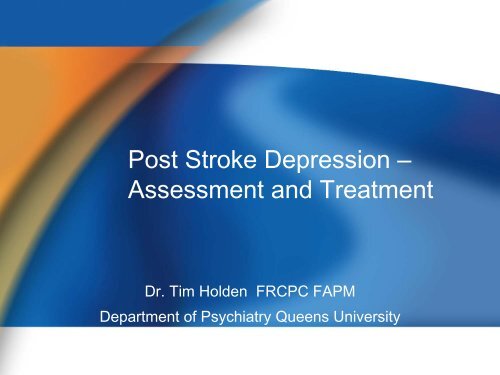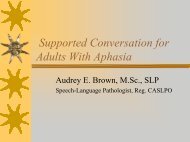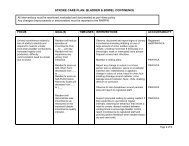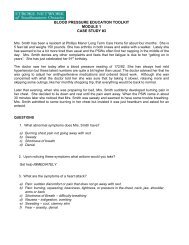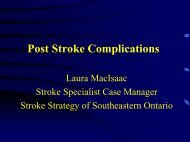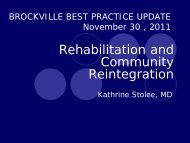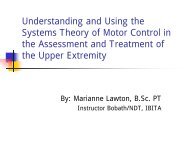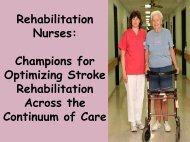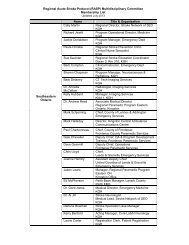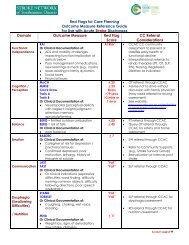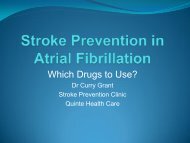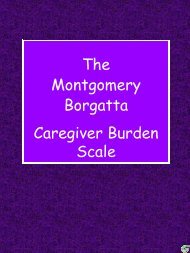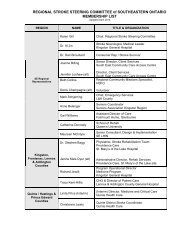Post Stroke Depression
Post Stroke Depression
Post Stroke Depression
- No tags were found...
You also want an ePaper? Increase the reach of your titles
YUMPU automatically turns print PDFs into web optimized ePapers that Google loves.
Disclosure of Potential for Conflict ofInterestDr. Tim Holden FRCPC<strong>Post</strong> <strong>Stroke</strong> <strong>Depression</strong>: Assessmentand TreatmentFINANCIAL DISCLOSURE: Occasional Honoraria fromTEVA and Lundbeck for community CME eventsOther: None
Objectives•To appreciate the incidence, prevalence and iompact of mooddisorders following stroke (PSD)•To review screening instruments and timing of assessment ofPSD•To comment on possible mechanisms of PSD•To review the pharmacological treatments used in strokepatients•To mention recent definitive studies on antidepressants•To comment on the differences between treatment of poststrokedepression and “non-medical” depression (MDD)•To promote discussion of resources available locally
<strong>Post</strong>-<strong>Stroke</strong> <strong>Depression</strong> Epidemiology•Prevalence rates vary amongst studies 20-50% depending onthe severity of the mood syndrome being assessed•Major <strong>Depression</strong> - 19.3% in hospitalised patients and inambulatory patients - 23.3% (so total higher)•Studies do not distinguish infarction from hemorrhage•<strong>Depression</strong> affects functional rehabilitation – probably throughthe establishment of a vicious cycle of dysfunction worseningdepression, lowering pain and frustration tolerance, impairingmotivation further worsening the rehabilitation and exacerbatingthe depression•Mood issues also complicated by cognitive impairment
Biology of <strong>Post</strong> <strong>Stroke</strong> <strong>Depression</strong>•Classical anatomical associations not supported by newtechnology that allows scans etc.•Previously PSD thought to be associated with Left Anterior andLeft Basal Ganglia lesions•Situation complicated by related conditions such as FrontalLobe Apathy and Emotional Lability (Supra Nuclear Palsy etc.)•Current work on the “multifactorial” nature of <strong>Post</strong> <strong>Stroke</strong><strong>Depression</strong>, integrating anatomical lesions with interruptedprojection pathways and subsequent alterations inneurotransmitters.
<strong>Depression</strong> in Medical illness:The (bad) “Good Reasons” argument•Empirically incorrect•Less than half of any medically ill population meet criteria formajor depression•“Understandability” may rationalise a serious treatable disorder•<strong>Depression</strong> vs. Despondency•Primary conceptual problem is the overlap between physicaland psychological symptoms•Seen particularly in chronic debilitating conditions (malignancy,autoimmune conditions, chronic infections) and neurologicaldisorders such as Multiple Sclerosis, Parkinsons Disease, ABIand <strong>Stroke</strong>
<strong>Depression</strong> Assessment –Timing andScreening Tools•Timing is important as mood changes in response to perceivedrate improvement•Most people initially optimistic – so no immediate depression•Occasional immediate depression if CVA affects uncommonanatomical area•4 – 6 weeks usually the crucial period•Remember the Kubler-Ross 5 stages of grieving (applies to anyloss, i.e emotional reaction differs with reaction phase•PHQ-9 is as good as any but BASDEC specifically useful•http://www.phqscreeners.com/overview.aspx•http://www.youtube.com/watch?v=DtQCp5350as
PDQ-9 -Example
BASDEC: a novel screening instrument fordepression in elderly medical inpatients.Adshead, Cody & Pitt. BMJ 1992;305:397“Caseness" and psychiatric diagnosis on brief assessmentschedule depression cards (BASDEC) and geriatric depressionscale (GDS)Psychiatric case Not a psychiatric caseBASDECBASDEC TotalGDS14 2 15 3 3 23Total 7 17 42 6 72
EMPIRICAL STUDIES•There are many looking at incidence, prevalence,outcome and associations between many different factors.•First methodologically sound study probably 1989•Many reviews but all types of studies lumped in together(don’t distinguish embolism from haemorrhage)•Recent Cochrane Review of post-stroke Emotionality butnot depression per se
Pessimistic meta analysisHackett ML et al.“Management of <strong>Depression</strong> After <strong>Stroke</strong>: A Review ofPharmacological Therapies”<strong>Stroke</strong> (2005)36:1092-1097•7 treatment trials with 615 patients•9 prevention trials 479 patients•Mood symptoms were improved in patients with severedepression only. No effect on minor depression.•No prophylactic effect
…but there are positive studies•Outnumber the negative studiesStarkstein S et al.“Antidepressant therapy in post-stroke depression”Expert Opinion on Pharmacotherapy 9(8):1291-8(2008)• Unsystematic review demonstrated efficacy for sertraline, citalopramand nortryptylline
Traditional (anecdotal) Therapies•Stimulants used even before the development ofantidepressants•MAOIs were not favoured due to side-effects•TCA’s long history though side-effects were limiting•Amitryptylline, imipramine, desipramine, trimipramine, doxepin(maprotiline) etc. All TCA’s•Trazadone used for mixed anxiety –depressive states•Desipramine still popular due to Noradrenergic action andminimal anticholinergic side effects•Specific benefit for emotionalism (? Mode of action)•Recent increased concern about prolonged QTc
Recommended ReviewWilliam Feinberg Lecture 2002“Emotions, Mood, and Behavior After <strong>Stroke</strong>”Bogousslavsky, J. <strong>Stroke</strong> 2003 (April) : pp 1046-1059This paper includes the tables that follow:
Development of poststroke depression (PSD)is associated with a poor functional outcome.(NIH indicates National Institutes of Health.)
Results of a Pool of Studies Assessing theVarious Potential <strong>Stroke</strong> Determinants ofPSD: Associated FactorsFactors Significant Nonsignificant<strong>Stroke</strong> severity 5 0<strong>Stroke</strong> side 1 7Lesion volume 3 2Anterior circulation 4 2Cognition 6 2Functional outcome 10 1
Results of a Pool of Studies Assessingthe Various Potential PersonalDeterminants of PSDFactors associated with post-stroke depressionSignificance in 13 StudiesFactors PositiveNegativeAge 6 6Gender, F 5 6Prior stroke 3 2Prior disability 0 2Prior depression 3 1
Are there stroke-specific factors?•Not really………..just be aware of side-effects•No reason not to follow standard CANMAT treatment guidelines•Start with an adequate trial of one SSRI etc.•Possible exceptions might be severe psychomotor retardationrequiring a stimulating agent such as bupropion or dexedrine•Another factor might be sleep disruption suggestingmirtazepine might be preferred or used in combination•2 recent studies are now regarded as definitive fordepression in general – not just post-stroke (i) STAR*D(NIMH) and (ii) The “Cipriani” study on ComparativeEfficacy and Acceptability of 12 New GenerationAntidepressants
Questions?
Escitalopram and post-stroke cognitive recovery• Jorge, EJ et al (College of Medicine and Biostatistics, Iowa)Escitalopram and Enhancement of Cognitive RecoveryFollowing <strong>Stroke</strong>Archives of General Psychiatry 67(2):187-196 (2010)“Patients on escitalopram showed improvement in globalcognitive functioning, specifically verbal and visual memoryfunctions, compared to patients who received placebo orProblem Solving Therapy. This beneficial effect wasindependent od its effect on depression.”
Addendum – time permittingTwo recent large studies have shown the relative benefits andtreatment results of the various available antidepressants innon-medical depression (though the results seem to apply toPSD).1) The STAR*D Study (ongoing)2) The Cipriani Study (2010)
STAR*D SequencedTreatment Alternatives toRelieve <strong>Depression</strong> StudyOngoing study has it’s own website through NIMHwith many downloadable tables and slides
Comparative efficacy and acceptability of12 new-generation antidepressants:a multiple-treatments meta-analysisCipriani A, et al.Lancet , February 2009
The Lancet 2009: Cipriani et al.Background• Independently funded meta-analysis that compared theefficacy and patient acceptability of 12 antidepressants• 117 randomised clinical trials (25 928 participants) from1991 - 30 th Nov. 2007• Included 12 new-generation anti-depressants:bupropion, citalopram, duloxetine, escitalopram, fluoxetine,fluvoxamine, milnacipran, mirtazapine, paroxetine, reboxetine,sertraline and venlafaxine• Assessed the acute treatment phase (first 8 weeks oftreatment) in adults with unipolar major depressive disorderCipriani et al., Lancet 2009; 373: 746-58
Results• Superior in efficacy:• Mirtazapine, escitalopram, venlafaxine, sertraline• Superior in acceptability:• Escitalopram, sertraline, bupropion, citalopram• Authors conclude:• “Clinically important differences exist betweenantidepressants”• “Both efficacy and safety in favour of escitalopram andsertraline”Cipriani et al., Lancet 2009; 373: 746-58
Efficacy Acceptability• Mirtazepine• Escitalopram• Venlafaxine• Sertraline• Citalopram• Bupropion• Paroxetine• Fluoxetine• Duloxetine• Fluvoxamine(Omits drugs not available in Canada)• Sertraline• Escitalopram• Bupropion• Citalopram• Fluoxetine• Mirtazepine• Venlafaxine• Paroxetine• Fluvoxamine• Duloxetine(ditto)


